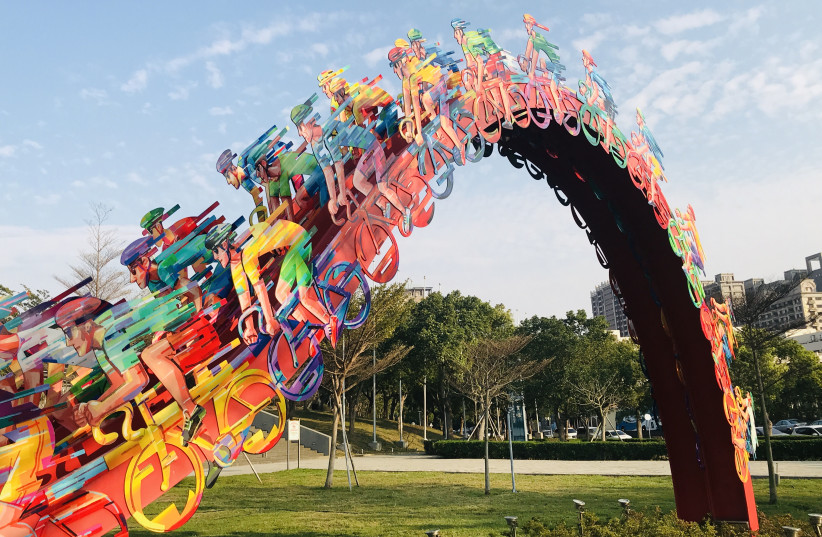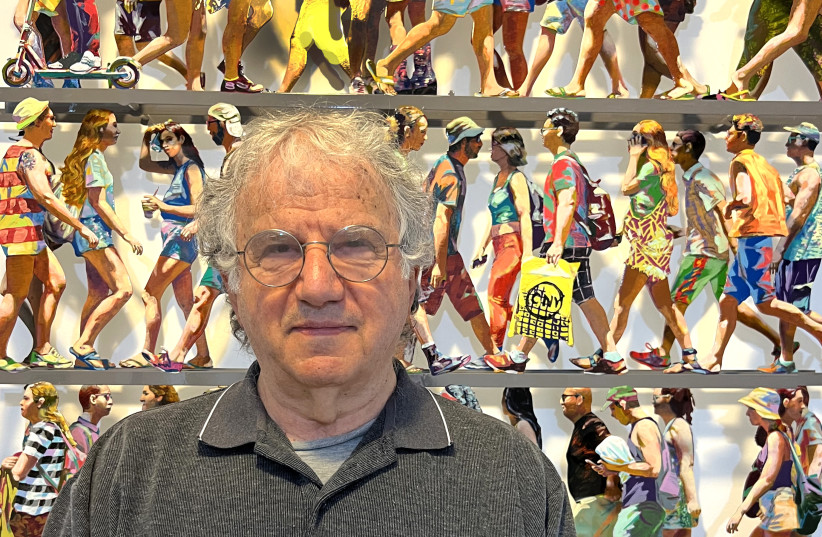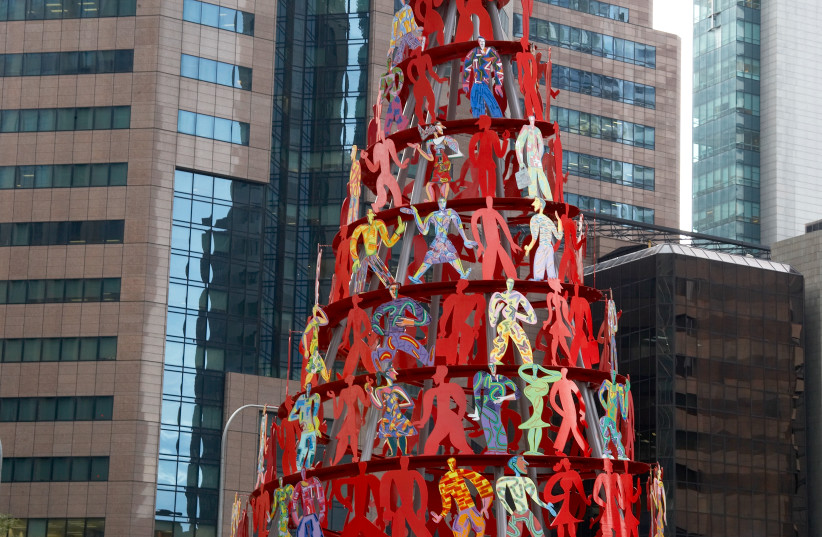Rabbi Eliezer quoting Rabbi Hanina said: “Those who cite the true source of their words bring salvation to the world.” [Talmud, Megillah]
David (Dudu) Gerstein is one of Israel’s best-known artists. At 77, he continues to invest 10-hour workdays, producing marvelously creative works known and loved throughout the world.
I recently visited his studio in the outskirts of Beit Shemesh, near Jerusalem, to discover the source of the fountain of youth – the wellsprings of the creative spark that drives him to continually create astonishing works of art, at an age when many have retired, willingly or not, to a comfortable armchair.
Following the wise Rabbi Eliezer, straight from the horse’s (or artist’s) mouth, here is the inside story of his artistic creativity, told in his own words. It may not save the world, but perhaps it will help inspire others to defy the age discrimination so prevalent in modern society, and to constantly seek new and innovative pathways.

Creative talent – nature or nurture?
“Creative talent is partly nature – innate. But not always. Some artists started at age 20, or 30, and became known.
“In my case, my parents had no background in the arts at all. With my twin brother and me, this talent emerged suddenly, unexpectedly, in kindergarten. All the children got crayons and began to draw. I and my brother fell in love with drawing. The kindergarten teacher told my parents, these two boys have real talent! So the talent did appear at an early age.
“The fact we were twins made us compete with one another, to see who could draw better. Each of us tried to draw lovely things, to show to mother and father and get a hug and a good word.
“This desire to excel and to grow – it started in kindergarten. I think you are born with it. But – you have to develop it. When everyone praised our art, we wanted to get better and better, to develop it, so we grew in skill quickly. We were encouraged, too, in elementary school. They bought us paints, notebooks to copy art, from an early age.
“There are many children who show talent at an early age, and later they abandon it. I recall that I was told, if you continue to do art after age 13 or 14, the age when you first develop self-criticism, then you will likely continue with it.
“Artistic talent really begins, and sometimes ends, when you can say critically: ‘Wait! This is not how to paint. I’m not good enough.’ With us, though, this did not happen. At an early age, people told us, you two will be artists. It is inevitable. Our parents said, maybe you should study engineering or medicine? But all those around us said no. We always said we will become artists. There are no other options! Art determined my future – not vice versa.”
<br>On the source of creative enthusiasm
“It is hard to explain. I often paint until late in the evening. The next morning, I look at my work and what I did surprises me. And it leads me to something else. Every day brings a new adventure! No two days are the same!
“What is my motivation? Not money. It is the need to do something I have not done before. It is for ‘likes.’ OK, I think: they will like this. This ‘like’ quest is addictive! The ‘likes’ are like my mother’s hug – as if she is saying, ‘Sweetie, how talented you are!’
“Even an elderly person still seeks the ‘likes.’ It’s a form of connection. When you are a child, it is your mother. When you are older, it is the people, the establishment, the surroundings, the world. When they say ‘like,’ you feel love, you feel you have accomplished something! I imagine that my work is enjoyed by millions and makes them happy.”
<br>On spontaneity
“You quote Picasso, ‘If I know what I am going to paint – why bother?’ I think I do not agree. At the start when he was influenced by Cezanne and developed cubism, he knew very well what he intended to do. So I don’t buy it.
“But Picasso also said, ‘I don’t seek, I find.’ If you have a direction, you often arrive at results you did not expect. There are many surprises in art. Every work is an adventure – you never know where you will get to. Those who, say, copy a photograph, they know the result. If you paint what you are inventing, you do not know in advance what the result will be. But you still need to have a general direction.
“Suppose you are painting two people conversing. You know you want to create some tension between them. Two men? Two women? Man and woman? You don’t know in advance. The result is often surprising. All the influences you have accumulated emerge in the work. But you have to start out on the journey. Before you depart, you need a direction. You need a map. You cannot just wander.”
<br>On creatively combining X and Y
“If I take a long perspective on this, I have always tried to join two extremes, figurative and abstract. Two dimensions and three dimensions. Decorative and expressive. I always had the idea of bringing together two opposites. This always guided me.
“With regard to sculpture – I painted a long series of balconies in the 1970s. It was completely figurative, based on my childhood memories. I was very proud of that work. After I completed it, I said, ‘OK, what’s next? Will I do more paintings of balconies? Perhaps I need to find something that better expresses what I think. Maybe I am too influenced by the history of art.’
“I had questions about where to go next. Then I said maybe I will do sculpture. I paint all the time. It’s pleasant, enjoyable. But sculpture is very physical. I look at sculptures and see what high energy sculptors have! Maybe painting is too easy. Maybe I need to tackle something harder. So I said let’s try sculpture.
“I started to sculpt in clay, molded in bronze. But no, I said, this is too ‘classical.’ Then I discovered that I could cut my paintings and put one on top of the other. That means you can see what is behind them, on the reverse side. So I continued to paint, but it became three-dimensional. In this way I did not lose my love of painting.
“To be a sculptor, you have to work with iron, stone – you lose the joy of painting. Here, I found a way to create 3D objects and to paint on them, so you can view them from any angle. This changed my viewpoint. I began to cut, to saw – it took me many years. And my friends told me, enough! You are such a good artist. Why are you making these ‘toys’? I said, listen. I love painting. But what gets me out of bed in the morning and gives me the passion to paint is to invent, to create – this fascinates me. My late wife too was not happy with me. She said, ‘you did lovely paintings, now you cut and paste’. But I felt it was bigger than me. Here, I found myself.

How the Peloton was born
“No idea is born from nothing. I have done a lot of work on bicycles – it has interested me for years, from childhood. I was fascinated by how people operated machines, why they don’t just topple over. The whole complex of people and bicycles greatly interested me for years. When they contacted me from Taiwan, they said, there is a competition to create sculptures for the new stadium here, would you agree to participate, to suggest ideas? I said, ‘OK, I’ll use the theme of bicycles.’
“I had already done wall sculptures of bicycles, so I said we’ll move it from the two dimensions of art hung on the wall and expand into three dimensions, in three-dimensional space. This developed from works in China, which has a tradition of dragons. I used that form, the wheel or “peloton” [a large group of bike riders bunched together], to create a 3D sculpture.
“At the site they allocated to me, there was a path that led to the stadium. I thought my sculpture could be like the gate or the entrance. But they did not want it there, so they put it on the side. There are always committees that decide these things.
“They chose my work from artists in Taiwan and the whole world. Later, in 2017, I won a prize for the best sculpture in Taiwan, out of 170 entries.
<br>On commercial success
“I achieved this only at age 50. Until then I did make a living, but it was difficult. I did not have financial security. You have to ‘scrape the bottom’ all the time. When I did attain some success at age 50, I understood that 50 is not the end of life. And today, I am 77. There are so many things I have yet to do. Every single day I have new ideas, desire to do new things. There seems to be no limit!”

On being a perpetual creator
“It’s hard to put my finger on the exact cause of this. Some insights I have gathered over the years. One of them is – as an artist, I wanted to be accepted, wanted the establishment to approve of me and my work. I never did achieve that. Why? Because I was always different from all the other artists.
“When I did figurative art, the dominant trend was minimalist. When I shifted to sculpture, painting was back in fashion. I was left behind, always not accepted or approved. I was out of step. An outsider. I was like an outsider, but inside the system. I was not a customs agent [like Henri Rousseau] who one day started to paint. I was in the establishment.
“I studied art at the leading institutes, but still I always felt like an outsider in the art world. I think that was my strongest motivator: to prove that I am good. It gave me no rest.
“To this day though – ands I have had solo exhibitions in galleries and museums all over the world – somehow I feel that here at home, in Israel, I am still not accepted.
“We all want to prove to our mothers and fathers that we are loved, that we are worth something. That still drives me. All the artwork you see around us? I still do not feel that I have succeeded. This is what has pushed me to prove I am worthy. Everything I do, apparently, is driven by that feeling. It’s not the only motivator. But it’s the main one!”
<br>‘Art for everyone!’
“My philosophy is, art should interact with people, it is not just for museums or the ivory tower. It should not be something baffling that people cannot make heads or tails out of. Art is a language for communicating. If you speak a language that nobody understands, then what have you achieved?
“When I speak to you about my childhood, I have made contact with you. But if you look at my art and it fails to communicate meaning, then I have failed. Art is a language of human contact!
“Art must be accessible in monetary terms, too. If someone wants to sculpt things only millionaires can afford, well, then again, you have failed.
“Of course, an artist has to make a living. And you cannot keep the price of your work from rising. But on the other hand, it bothers me when people cannot afford to buy it.
“One day, a couple came to me and said, we love your work but forgive us, we can’t afford to buy it. Can you make us something small, less expensive, that we can put in our home? I thought, why did I not think of this before? So I did small sculptures and painted them by hand. And people loved them! I thought, I can’t paint each by hand, this is not feasible, but maybe let’s print them. I did small sculptures and printed them, by silk screen, and began to sell them.
“The art galleries really did not like this idea! They told me, what are you thinking? We want to sell your work for high prices. I said, listen, each work has its proper place. You can sell the Mona Lisa, the original, and you can also sell reproductions. I will make reproductions of my own work. I want everyone who chooses to afford it and spread my name worldwide. Like it or not, I am going to do this!
“I started doing reproductions and it created a huge market for me. Not a museum crowd. Not a crowd of people who believe that only they truly understand artwork. Instead, people who consume art, enjoy art and live with it, gain inspiration from it. That is what art is for! So these buyers became my ambassadors. My art got to Australia, China, Singapore, South America. People started to Google ‘Gerstein’. And suddenly a whole new group of fans arose that I had not known before!
“Later, other artists told me, ‘Gerstein, you are right!’ And they too followed suit. It became a genre. At times, I am not fond of what others do in this vein, but it is out of my hands. It has become a trend.
“For me, this too was swimming against the tide. I recall that an art critic once wrote about me, critically, that I am ‘commercial,’ a ‘pop artist.’ A year later, she launched a company to make inexpensive works of art, art objects, and even set up a sales booth at Tel Aviv Museum to sell them. I told her, ‘D., well done! Very nice!’ She said, ‘You are the father of this idea.’
“If I were an artist who did only what was acceptable and approved, if I thought about what they might say about my art – no, I don’t think this way! I work only according to my own worldview – what I believe art should be. I listen to myself. To make art accessible to the people, this is an integral part of art.”

Advice to young artists
“Often, young artists come to see me and ask me, can you give us tips on how to sell, make a living, become known? You did it!
“I tell them: there are no shortcuts! Do something nobody else has done before. Make people say ‘wow!’ That will open doors for you. Until you do something unique, you have no chance. If others did it before you, maybe better than you, you will have little to offer. Do something unique. Instead of spending time on public relations, work on finding ways to do something nobody else has done before. I think this is my best advice to a young artist who has just finished art school. Don’t copy what has already been done. Maybe you are good at copying the work of your teachers. If so, then you will always remain a follower, not a leader. Do what others have not thought of. Make a breakthrough! So they will say, why didn’t I think of that?
“The American artist Chuck Close took photographs of himself and his friends, enlarged them to huge sizes, three meters or more, then painted over them with an air brush, not a paint brush. Everyone said, what is this? Photograph? Painting? He became one of the most prominent artists of the 20th century.
“So, don’t imitate your teachers. This is creativity. Swim against the tide!” ■
The writer heads the Zvi Griliches Research Data Center at S. Neaman Institute, Technion, and blogs at www.timnovate.wordpress.com
